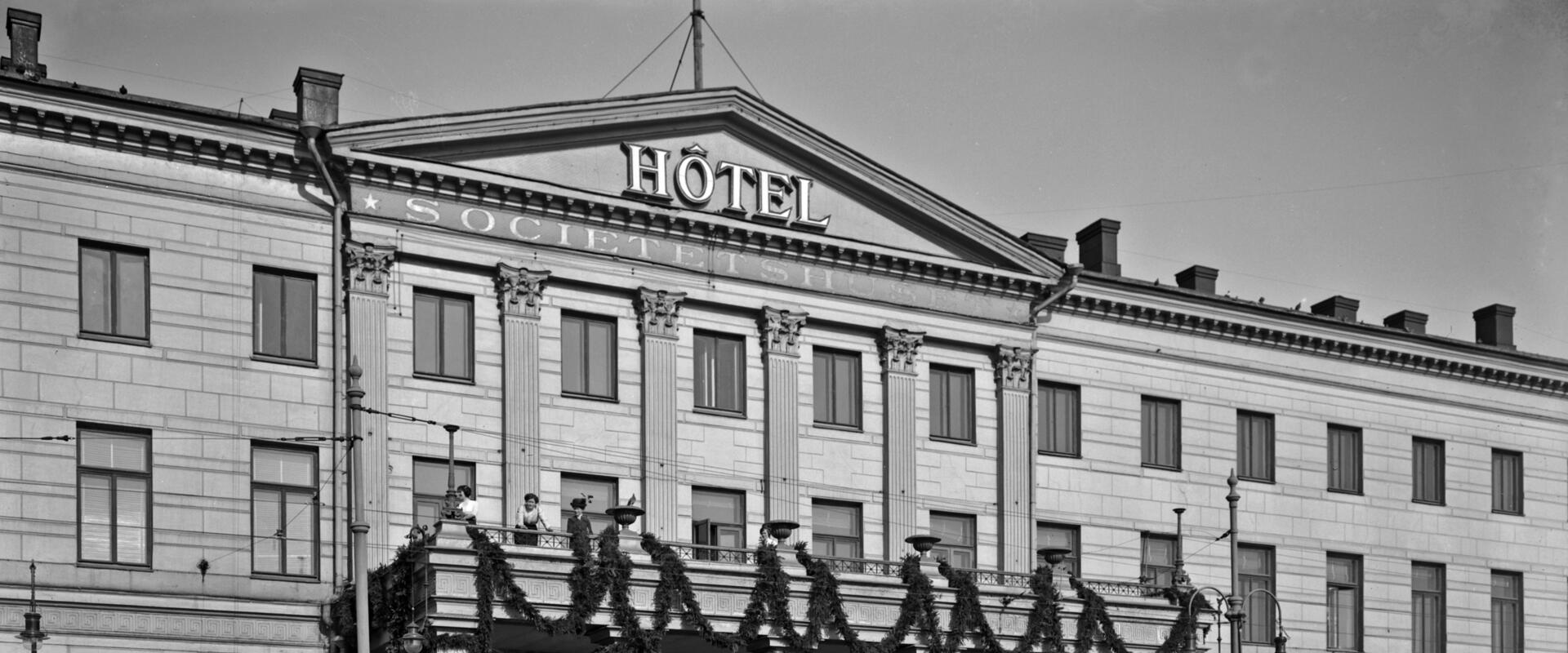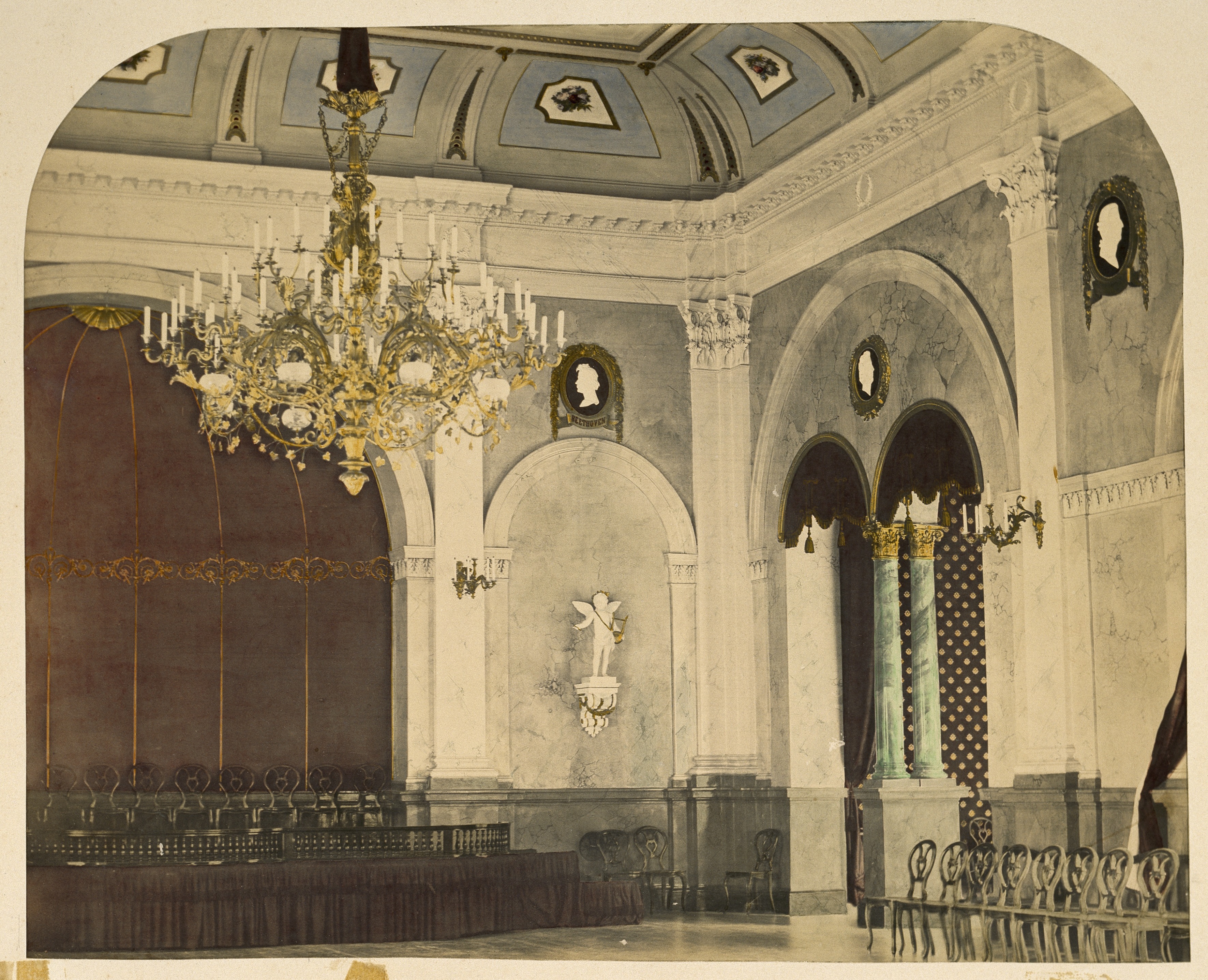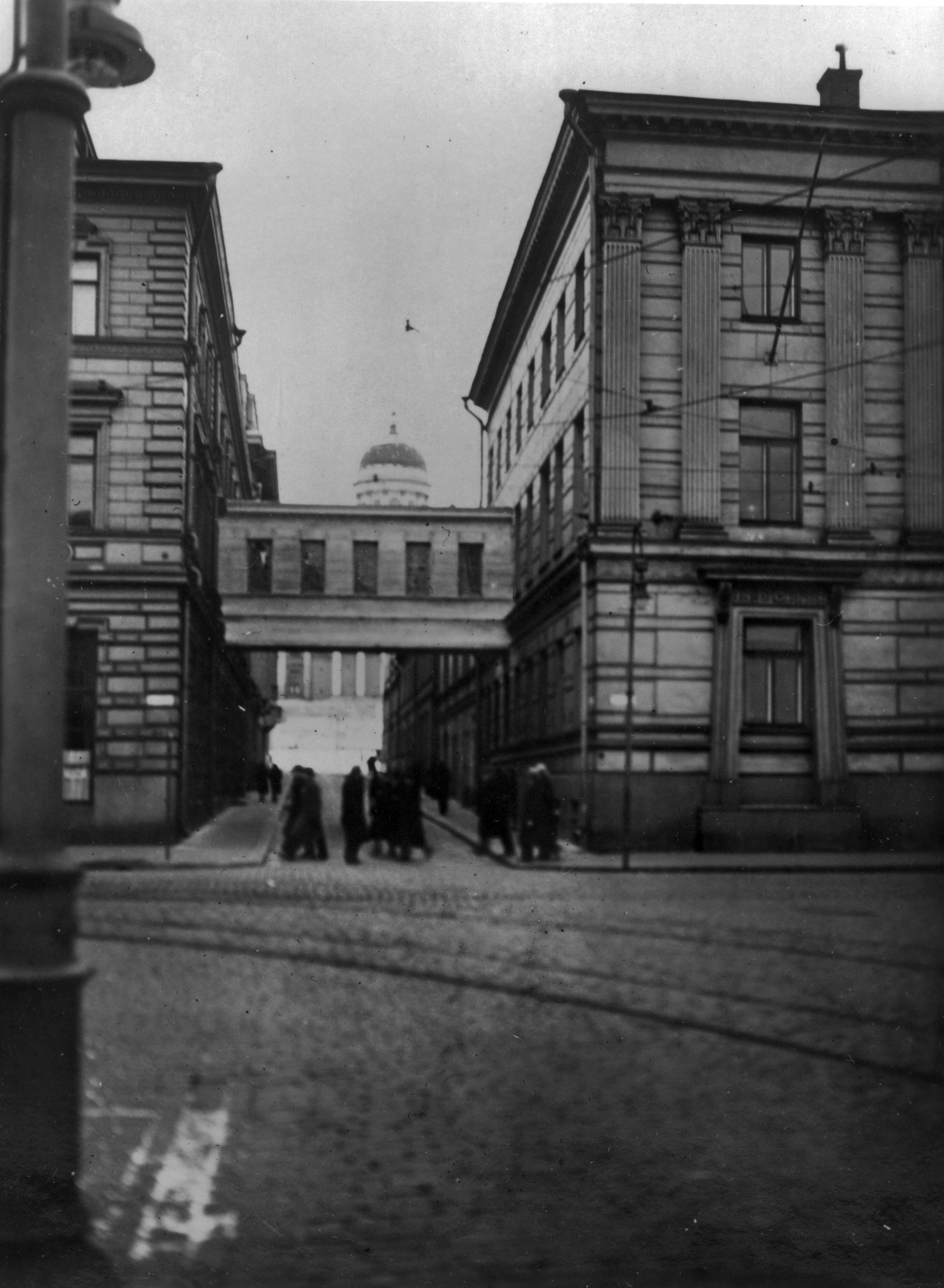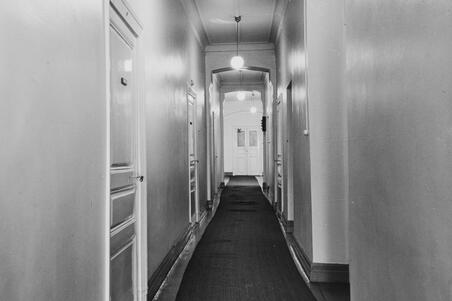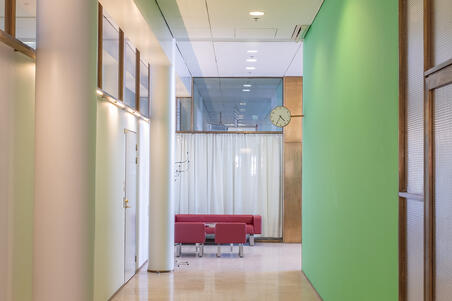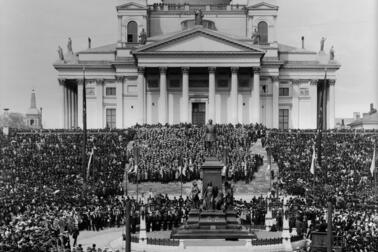The old Seurahuone hotel designed by Engel
When Helsinki became the capital of the Grand Duchy of Finland in 1812, the city quickly needed new fine architecture to reflect the new imperial Helsinki. This is perhaps best evident today in the Senate Square, but there is also a hint of the 19th century imperial (Empire) style at the Market Square.
One of the lesser known but once very important buildings in the new capital was the Seurahuone hotel. It was a combination of a venue, hotel and restaurant, designed by none other than Carl Ludvig Engel, the chief architect of imperial Helsinki. Inaugurated in 1833, the building became the city’s most important and imposing banquet hall for decades. After the establishment of the Diet of Finland and the opening of the railway in the 1860s, Helsinki and Seurahuone became even busier. The building was used for balls, conferment ceremonies, post-defence parties, theatre performances and concerts. The banquet hall was and still is ornate, reflecting the aesthetics of the late 19th century. It was designed by Hampus Dahlström and extended by Bruno Granholm. Concerts, balls, receptions and other events for invited guests have been held under the crystal chandeliers. The hall has hosted many first performances of Finnish composers, such as The Wood Nymph by Sibelius. The first cinema screening in Finland also took place there in 1896.
Up until the 19th century, the Helsinki City hall (raatihuone) was a wooden building that stood on Suurtori (now the Senate Square), which burned down, accidentally or on purpose, several times in the course of history. A new stone City Hall was not built until 1804, and it was demolished 30 years later to make way for the new imperial Senate Square. In 1838–1913, the Bock House in the Senate Square (Aleksanterinkatu 20) served as the City Hall. The building was built in 1763 as the home of merchant Gustav Johan Bock, but C. L. Engel made changes to it in the 19th century when it was made the temporary residence of the Governor-General, the highest official of the Grand Duchy of Finland. Helsinki City Council convened there from 1875. The nearby Burtz and Helenius Houses were also acquired by the city, which was the start of a coherent city hall block.
Dream of a new city hall fails
The second half of the 19th century marked many changes in the history of Helsinki and the whole of Finland. Novelties in Helsinki included the railway (1862), bus transport (1888), electric lights (1884) and the metric system (1887). The reforms of Tsar Alexander II of Russia, depicted in a statue in the middle of the Senate Square, included not only the restoration of the Diet of Finland but also a local government reform. It was now up to the cities to take care of everything that used to be the responsibility of the bourgeoisie and the church (e.g. poor relief, schools, security). Helsinki received an elected council, although in practice only rich men were able to vote (women, servants and the indigent were not eligible to vote). This still marked a significant change: previously, the city was run almost entirely by the bourgeoisie (merchants, craftsmen) and provincial and state officials.
The new institution was to be housed in a building suited for its stature, which would also serve as the focal point of the city’s newly expanded administration. To this end, the city decided to buy the Seurahuone hotel, which was undeniably one of the most imposing buildings in the city. Astonishingly, the buildings that Engel designed – which evoked the grandeur of imperial Helsinki – had lost their appeal in less than a hundred years. People wanted something new and different. The plan was to build a brand new city hall to replace Seurahuone. The project was spearheaded by senator Leo Mechelin, the chairperson of the City Council. Similar new city halls had already been built in many other cities of the Grand Duchy: Loviisa, Pietarsaari, Vaasa, Hämeenlinna, Kuopio and Porvoo. The capital clearly lagged behind the regional centres.
A design competition for the new city hall was held, but people were not satisfied with the results. No first prize was awarded and the second prize went to Armas Lindgren (the architect who designed the National Museum and the New Student House, among other buildings), whose design was reminiscent of a central European and medieval city hall. The matter was tabled, and then the First World War intervened, followed by the Finnish Civil War, during which Helsinki was occupied twice: first by the Reds and then by the Germans. The matter was revisited after the war, but people opposed the new building both as being too expensive and because it would mean destroying a fine old building. In the end, a compromise was reached: the old Seurahuone was retained but renovated into a city hall under the direction of city architect Gunnar Taucher. The renovation was completed in 1932.
After the Second World War and a major annexation in 1946, Helsinki was growing fast. The city administration also grew, and soon the City Hall was found to be inadequate yet again. At first, the changes made were small but important for the employees, the most important being Kaupunginkellari, a restaurant for civil servants built in 1940 beneath what was the ground floor of the building at the time. The young artist Tove Jansson was commissioned to paint frescoes in the restaurant.
Bigger city needs more space
The facilities were yet again found to be inadequate in the 1960s. A decision to renovate the old building instead of building a new one was made also this time, but this time the renovation was more extensive. Aarno Ruusuvuori won the renewal competition with his entry “Kivinen eläintarha” (the Stone Zoo). A strong modernist craze was the spirit of the times. Older styles were considered stuffy and impractical. At the start of the renovation, the old Seurahuone building, i.e. the City Hall, was almost completely demolished, and a modern office building was constructed inside its old walls. Only the facade, the main entrance vaulting and the banquet hall were kept as reminders of the bygone times.
Ruusuvuori’s office designed the building with all its details, striving for a holistic piece of art. Ruusuvuori commissioned Anitra Lucander to design the colour scheme. In 1970, the office employees returned to the renewed building where the building technology had been updated. The interior had been completely renovated, replacing the Empire-style ornaments with modernist details. Many impressive pieces of art were also designed for the City Hall lobby in the early 1970s: Wall of Light (1971) by Eino Ruutsalo, ceramic relief City in the Sun (1975) by Rut Bryk and Chain (1971) by Kimmo Kaivanto. The sculpture People Through the Ages (1971) by Eila Hiltunen, who also designed the Sibelius Monument, was placed in the mayor’s reception lobby. The downstairs lobby was also an excellent exhibition space: international exhibitions were arranged there from time to time in the 1970s and 1980s.
The long and extensive renovation of the City Hall was completed in the autumn of 1970, after which the old building was barely to be seen. Just before the completion of the renovation in 1970, a significant and somewhat heated discussion about the importance of building conservation started in Helsinki. The City Hall became the focal point of this discussion, as Ruusuvuori’s renovation was criticised for its high price and long duration. Another discussion topic was the negligence towards a historically significant building – the old Seurahuone.
In the 1980s, Ruusuvuori’s office also designed a new wing in the centre of the block to house a new modern council chamber and a new restaurant. These were completed in 1988 and are still in use today.
At the turn of the 1990s, the City Hall had reached the end of its technical service life and was no longer compliant with the requirements for a modern administrative building. The 1998–1999 modernisation by the architect’s office Aki Davidsson was mainly limited to the first stage of Ruusuvuori’s project, i.e. the southern part of the City Hall block.
The plastering and plasterwork on the facade were renewed. The faded building was repainted in blue and the side wings in light pink. The building was fitted with systems that met the modern standards. Asbestos, a popular building material of its time that is now classified as hazardous, was a major problem, as there was plenty of it in the City Hall. The asbestos in the ceilings was replaced with an acoustic cotton spray. The original lamps in the lobby, designed by Ruusuvuori, were kept, as well as the original colour scheme of the corridors, the locations of doors and related electrics. The largest functional changes were made in the lobby. The cloakroom was moved to the back of the lobby, and Eino Ruutsalo’s kinetic light wall was moved to border the area. New lift doors were opened up to both sides of the lobby, and room for an information desk that serves customers was cleared in the middle.
The City Hall lobby was opened for city residents in November 2008 as a part of an effort to invigorate the old Empire-style city centre. The lobby was to be an open living room for the residents. Helsinki-tiedotus info point and an exhibition space were moved from Jugendsali in the neighbouring block to the City Hall lobby. The information office was named Virka-info and the exhibition facility Virka Gallery.
One of the major changes was opening a new door to Sofiankatu in the autumn of 2009. Jorma Puranen’s photography piece Where Compasses All Go Mad was placed on the wall in the adjacent stairway. Eino Ruutsalo’s Wall of Light (1971) was turned 180 degrees towards the cloakroom by the back wall to create a large and impressive space for exhibitions in the middle of the lobby.
Exhibitions that presented Helsinki from different viewpoints were arranged in the Virka Gallery. Thanks to its size and simple style, the gallery was well-suited for photographic exhibitions, and there were many such by famous photographers. Many concerts and other events were held in the lobby and banquet hall. The number of visitors grew from year to year, as tourists found the City Hall’s services.
In 2012, Helsinki celebrated its 200th year as the capital of Finland, and Helsinki was also the World Design Capital the same year. An essential part of the World Design Capital year was the opening of different interesting facilities that are normally closed to the public. The Virka Gallery “released” the lobby’s stunning grand toilets to arrange the FLUSH! art exhibition, displaying interesting pieces of contemporary art by famous young artists.
The heads of state of the Nordic countries celebrated Finland’s 100 years of independence in the banquet hall of the City Hall in the summer of 2017 by having lunch with Jan Vapaavuori, the newly elected mayor. The festive year was crowned by Kersti Kaljulaid, the President of Estonia, visiting the Bridge exhibition that celebrated the coinciding 100th anniversaries of Finland and Estonia.
In the past ten years, all the Nordic heads of state and the presidents of the Baltic countries have visited the City Hall. There have also been visitors from many European countries, Asia, Africa and Australia.
More than 50,000 people visited the City Hall in 2009. By 2017, the number of visitors had increased tenfold, exceeding half a million. As the City Hall was built for office and PR use in the 1970s, the structures and materials in the lobby were not durable enough for such an influx of visitors. The delicate sandstone floors and brass-detailed toilets Ruusuvuori had designed 50 years earlier literally started to come apart.
The lobby concept was once again reinvented in the autumn of 2018, which brought an end to the information and exhibition activities. In the spring of 2019, Event Square was opened in the middle of the lobby. It is used for different types of events and occasions. A media wall was put up in place of Eino Ruutsalo’s Wall of Light. A long-awaited door connecting the lobby to the City Hall restaurant was finally added.
